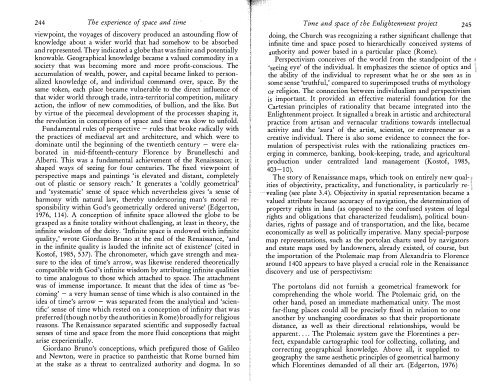The Condition of Postmodernity 13 - autonomous learning
The Condition of Postmodernity 13 - autonomous learning
The Condition of Postmodernity 13 - autonomous learning
You also want an ePaper? Increase the reach of your titles
YUMPU automatically turns print PDFs into web optimized ePapers that Google loves.
244 <strong>The</strong> experience <strong>of</strong> space and timeviewpoint, the voyages <strong>of</strong> discovery produced an astounding flow <strong>of</strong>knowledge about a wider world that had somehow to be absorbedand represented. <strong>The</strong>y indicated a globe that was finite and potentiallyknowable. Geographical knowledge became a valued commodity in asociety that was becoming more and more pr<strong>of</strong>it-conscious. <strong>The</strong>accumulation <strong>of</strong> wealth, power, and capital became linked to personalizedknowledge <strong>of</strong>, and individual command over, space. By thesame token, each place became vulnerable to the direct influence <strong>of</strong>that wider world through trade, intra-territorial competition, militaryaction, the inflow <strong>of</strong> new commodities, <strong>of</strong> bullion, and the like. Butby virtue <strong>of</strong> the piecemeal development <strong>of</strong> the processes shaping it,the revolution in conceptions <strong>of</strong> space and time was slow to unfold.Fundamental rules <strong>of</strong> perspective - rules that broke radically withthe practices <strong>of</strong> mediaeval art and architecture, and which were todominate until the beginning <strong>of</strong> the twentieth century - were elaboratedin mid-fifteenth-century Florence by Brunelleschi andAlberti. This was a fundamental achievement <strong>of</strong> the Renaissance; itshaped ways <strong>of</strong> seeing for four centuries. <strong>The</strong> fixed viewpoint <strong>of</strong>perspective maps and paintings 'is elevated and distant, completelyout <strong>of</strong> plastic or sensory reach.' It generates a 'coldly geometrical'and 'systematic' sense <strong>of</strong> space which nevertheless gives 'a sense <strong>of</strong>harmony with natural law, thereby underscoring man's moral responsibilitywithin God's geometrically ordered universe' (Edgerton,1976, 114). A conception <strong>of</strong> infinite space allowed the globe to begrasped as a finite totality without challenging, at least in theory, theinfinite wisdom <strong>of</strong> the deity. 'Infinite space is endowed with infinitequality,' wrote Giordano Bruno at the end <strong>of</strong> the Renaissance, 'andin the infinite quality is lauded the infinite act <strong>of</strong> existence' (cited inKost<strong>of</strong>, 1985, 537). <strong>The</strong> chronometer, which gave strength and measureto the idea <strong>of</strong> time's arrow, was likewise rendered theoreticallycompatible with God's infinite wisdom by attributing infinite qualitiesto time analogous to those which attached to space. <strong>The</strong> attachmentwas <strong>of</strong> immense importance. It meant that the idea <strong>of</strong> time as 'becoming'- a very human sense <strong>of</strong> time which is also contained in theidea <strong>of</strong> time's arrow - was separated from the analytical and 'scientific'sense <strong>of</strong> time which rested on a conception <strong>of</strong> infinity that waspreferred (though not by the authorities in Rome) broad I y for religiousreasons. <strong>The</strong> Renaissance separated scientific and supposedly factualsenses <strong>of</strong> time and space from the more fluid conceptions that mightarise experientially.Giordano Bruno's conceptions, which prefigured those <strong>of</strong> Galileoand Newton, were in practice so pantheistic that Rome burned himat the stake as a threat to centralized authority and dogma. In soTime and space <strong>of</strong> the Enlightenment project 245doing, the Church was recognizing a rather significant challenge thatinfinite time and space posed to hierarchically conceived systems <strong>of</strong>authority and power based in a particular place (Rome).Perspectivism conceives <strong>of</strong> the world from the standpoint <strong>of</strong> the'seeing eye' <strong>of</strong> the individual. It emphasizes the science <strong>of</strong> optics andthe ability <strong>of</strong> the individual to represent what he or she sees as insome sense 'truthful,' compared to superimposed truths <strong>of</strong> mythologyor religion. <strong>The</strong> connection between individualism and perspectivismis important. It provided an effective material foundation for theCartesian principles <strong>of</strong> rationality that became integrated into theEnlightenment project. It signalled a break in artistic and architecturalpractice from artisan and vernacular traditions towards intellectualactivity and the 'aura' <strong>of</strong> the artist, scientist, or entrepreneur as acreative individual. <strong>The</strong>re is also some evidence to connect the formulation<strong>of</strong> perspectivist rules with the rationalizing practices emergingin commerce, banking, book-keeping, trade, and agriculturalproduction under centralized land management (Kost<strong>of</strong>, 1985,403-10).<strong>The</strong> story <strong>of</strong> Renaissance maps, which took on entirely new qualities<strong>of</strong> objectivity, practicality, and functionality, is particularly revealing(see plate 3.4). Objectivity in spatial representation became avalued attribute because accuracy <strong>of</strong> navigation, the determination <strong>of</strong>property rights in land (as opposed to the confused system <strong>of</strong> legalrights and obligations that characterized feudalism), political boundaries,rights <strong>of</strong> passage and <strong>of</strong> transportation, and the like, becameeconomically as well as politically imperative. Many special-purposemap representations, such as the portolan charts used by navigatorsand estate maps used by landowners, already existed, <strong>of</strong> course, butthe importation <strong>of</strong> the Ptolemaic map from Alexandria to Florencearound 1400 appears to have played a crucial role in the Renaissancediscovery and use <strong>of</strong> perspectivism:<strong>The</strong> portolans did not furnish a geometrical framework forcomprehending the whole world. <strong>The</strong> Ptolemaic grid, on theother hand, posed an immediate mathematical unity. <strong>The</strong> mostfar-flung places could all be precisely fixed in relation to oneanother by unchanging coordinates so that their proportionatedistance, as well as their directional relationships, would beapparent . ... <strong>The</strong> Ptolemaic system gave the Florentines a perfect,expandable cartographic tool for collecting, collating, andcorrecting geographical knowledge. Above all, it supplied togeography the same aesthetic principles <strong>of</strong> geometrical harmonywhich Florentines demanded <strong>of</strong> all their art. (Edgerton, 1976)
















